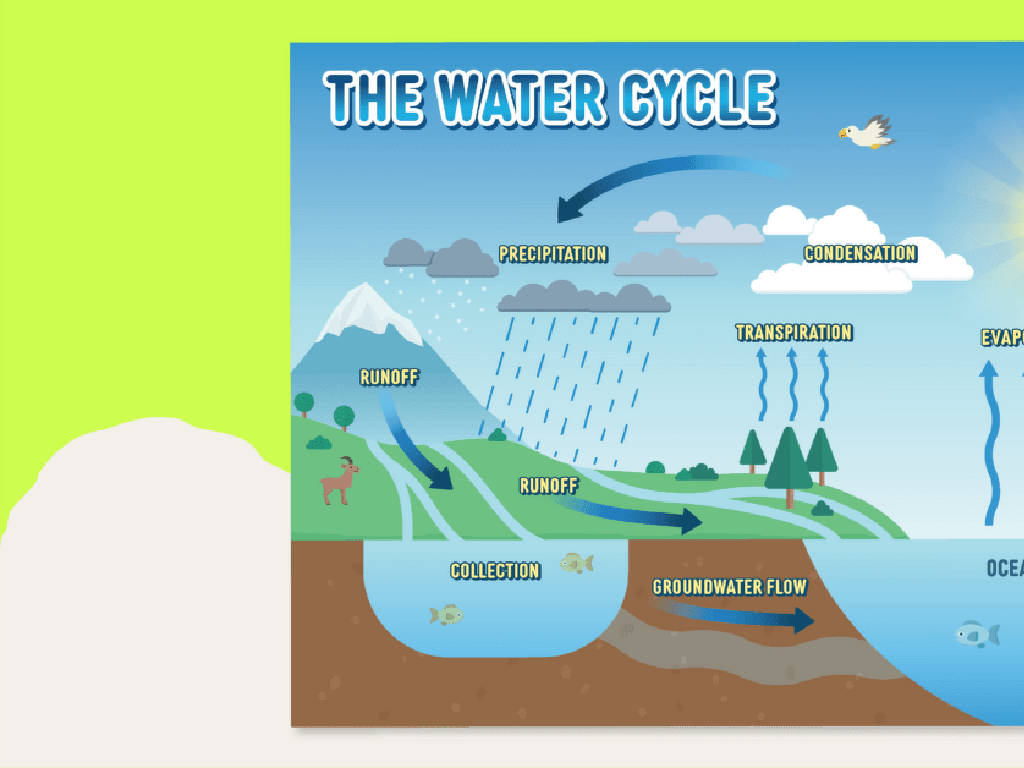Read A Thermometer
Subject: Science
Grade: Second grade
Topic: Weather
Please LOG IN to download the presentation. Access is available to registered users only.
View More Content
Introduction to Weather
– What is weather?
– Types of weather
– Examples: Sunny, Rainy, Windy, Snowy
– Why know the weather?
– Helps us plan our day and stay safe
– Reading a thermometer
– Thermometers tell us how hot or cold it is
|
Begin the lesson by asking students what they know about weather and why it’s important. Explain that weather is the state of the atmosphere at a place and time, affecting our daily lives. Introduce the different types of weather such as sunny, rainy, windy, and snowy, and use visuals to help them understand. Discuss the importance of knowing the weather for choosing appropriate clothing and activities. Introduce the concept of a thermometer and its role in measuring temperature, which is a key aspect of weather. This will set the stage for a deeper dive into how to read a thermometer in subsequent slides.
Understanding Thermometers
– A thermometer measures temperature
– Types: Digital and Mercury
– Digital shows numbers; Mercury uses a red line
– How to read a thermometer
– We look where the red line or numbers stop
– Safety with thermometers
– Always handle with care, especially glass ones
|
Begin the lesson by explaining that a thermometer is a tool scientists and doctors use to find out how hot or cold something is, which is its temperature. There are two main types of thermometers: digital ones that show the temperature with numbers on a screen, and mercury ones that have a little red line inside that moves up and down to show the temperature. Teach the students how to read both types by looking at where the red line ends or what the number on the screen says. Emphasize the importance of handling thermometers carefully, especially the glass mercury ones, as they can break and the mercury inside is not safe to touch. You can demonstrate how to use a thermometer and allow the students to practice with supervision.
Understanding Temperature
– What is temperature?
– It’s a measure of how hot or cold something is.
– Comparing hot and cold
– Hot things can burn, cold can freeze.
– Measuring temperature
– We use thermometers to find out the exact temperature.
– Importance of temperature
– Knowing temperature helps us dress right and stay safe.
|
Begin the lesson by explaining that temperature tells us how hot or cold something is, using examples like ice cream being cold or the sun feeling hot. Discuss the differences between hot and cold temperatures, and how they affect our daily lives, such as choosing the right clothes. Introduce the thermometer as a tool for measuring temperature and explain why it’s important to know the temperature to make decisions like what to wear or when to play outside. Encourage students to think about times when they’ve experienced very hot or cold temperatures and how it made them feel or act differently.
Reading a Mercury Thermometer
– Identify thermometer parts
– Bulb holds mercury; scale shows temperature; tube guides mercury
– Understand mercury movement
– Mercury expands when warm, contracts when cool
– Practice reading temperatures
– Look where mercury ends on the scale to read temperature
– Discuss temperature changes
|
This slide introduces students to the basics of using a mercury thermometer. Start by explaining the different parts: the bulb that contains the mercury, the scale with numbers that show the temperature, and the tube that the mercury moves through. Discuss how mercury reacts to temperature changes, expanding when it’s warm and contracting when it’s cool, which is how we can read the temperature. Have students practice by looking at example thermometers and identifying the temperature by reading the scale. Encourage them to think about how the weather outside might affect the reading on the thermometer. This practical exercise will help solidify their understanding of temperature measurement.
Reading a Digital Thermometer
– How digital thermometers work
– They use sensors to measure temperature quickly and display it on a screen.
– Benefits of digital thermometers
– They’re fast, easy to read, and more accurate than older types.
– Practice reading temperatures
– Look at the numbers and the unit displayed. Is it in Fahrenheit or Celsius?
– Understanding temperature units
– Learn the difference between degrees Fahrenheit and Celsius.
|
This slide introduces students to digital thermometers and their functionality. Explain that digital thermometers use electronic sensors to measure temperature, which makes them quick and accurate. Highlight the advantages such as ease of use, quick readings, and improved accuracy over mercury thermometers. Engage the students in a practical activity where they practice reading temperatures from digital thermometers, ensuring they pay attention to the units used (Fahrenheit or Celsius). Discuss the importance of understanding both temperature units as they are commonly used in different contexts. The activity should involve examples with different temperatures to help students become comfortable with reading and interpreting the data from a digital thermometer.
Let’s Measure Temperature!
– Measure indoor temperature
– Record outdoor temperature
– Compare both temperatures
Is it warmer inside or outside?
– Discuss findings as a class
Share what you observed with the class.
|
This slide introduces a hands-on classroom activity where students will learn to read a thermometer by measuring the temperature both inside and outside the classroom. Provide thermometers to the students and guide them on how to read the temperature accurately. Have them record their findings on a chart. Once everyone has recorded their data, lead a discussion on the differences in temperature. Ask questions like ‘Why do you think it’s warmer/cooler inside?’ and ‘How does the weather outside affect our indoor temperature?’ This activity will help students understand the practical use of a thermometer and the concept of temperature variation in different environments. Possible activities include comparing temperatures in different parts of the school, measuring the temperature at different times of the day, or predicting the next day’s temperature based on current readings.
Understanding Thermometers
– Importance of reading thermometers
– Helps us prepare for the day’s weather
– Temperature’s role in daily life
– Decides what to wear, when to play outside
– Recap on using thermometers
– Mercury and digital thermometers may differ
– Practice makes perfect
|
This slide wraps up our lesson on thermometers by emphasizing their importance in everyday decision-making, such as choosing appropriate clothing or planning outdoor activities. Understanding how temperature affects our environment helps us adapt to different weather conditions. We’ve learned that mercury thermometers have a line of liquid that rises with heat, while digital thermometers display numbers electronically. Encourage students to practice reading both types at home with a parent. Remind them that being able to read a thermometer is a useful skill that they will use throughout their lives.






